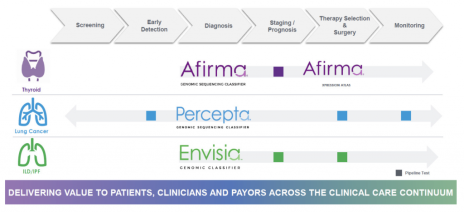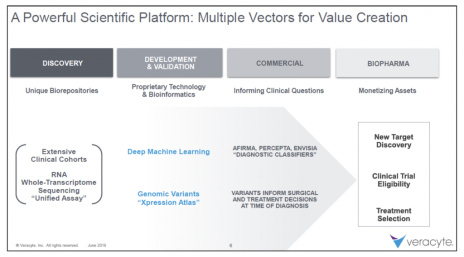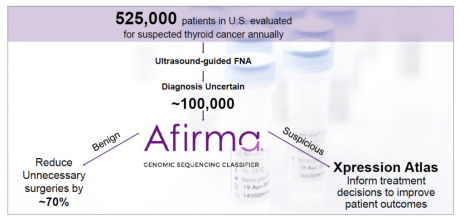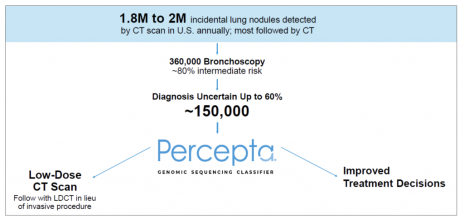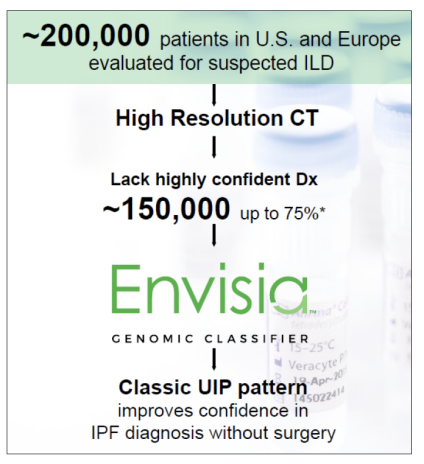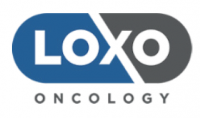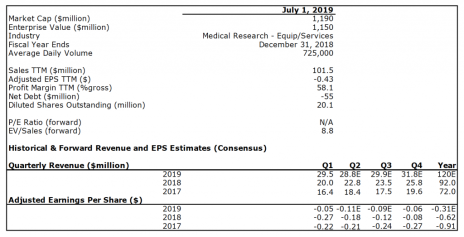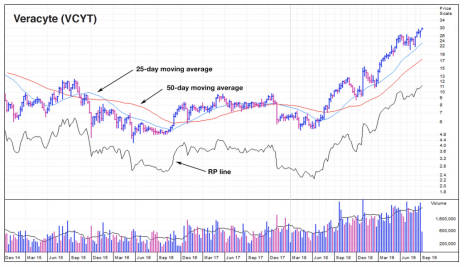Today’s recommendation is another company tapping into the explosive growth in genomic testing. It makes diagnostic tests, which pits it against larger rivals like Illumina (ILMN) and Gardant Health (GH). But this small company plays in three very specific markets where its next-gen products are emerging as market leaders. And new collaborations with the likes of Johnson and Johnson (JNJ) and Loxo Oncology, now part of Eli Lilly (LLY), are further evidence that it’s on the right path. All the details are inside. Enjoy, and Happy 4th of July!
Cabot Small Cap Confidential 242
[premium_html_toc post_id="180680"]
THE BIG IDEA
A few years back the Institute of Medicine (IOM) published a report with an astounding conclusion:
Most people will experience at least one diagnostic error in their lifetime, sometimes with devastating consequences.
That’s not cool.
Diagnostic accuracy of some conditions is staggeringly bad. For instance, the IOM’s data suggest that out of the hundreds of thousands of patients with suspected cases of thyroid and lung cancer, diagnosis is ambiguous 15% to 70% of the time.
That’s a huge range. Especially when you consider that, in many instances, patient samples are obtained by intrusive surgery.
Scientists are working feverishly to develop genomic and proteomic tests that can better detect disease in the early stages, or even when no disease is present, at low cost to payers and high convenience to patients.
Today we’re investigating a company that develops diagnostic tests for three markets. Before we get to the company, let’s take a quick look at the three diseases and the current state of diagnostic tests for each.
First up is thyroid cancer. Roughly $500 million is spent in the U.S. every year trying to diagnose potentially cancerous thyroid nodules. Over 525,000 fine needle aspiration (FNA) biopsies are taken, and around 30% of tests come back unclear. That often leads to thyroid surgery to gain more information, and 70% to 80% of those come back as benign. In other words, they were not necessary.
Lung cancer isn’t any better. Around 235,000 people are diagnosed in the U.S. each year, and 160,000 die. Bronchoscopies, a non-surgical procedure used to evaluate people that could have cancerous lung nodules, are completed on about 350,000 people. Roughly 70% of those are inconclusive! That leads to a lot of unnecessary diagnostic surgeries for lung cancer.
Then there is Idiopathic Pulmonary Fibrosis (IPF), a type of chronic lung-scarring disease that is difficult to diagnose in the roughly 200,000 people that are suspected of having it in the U.S. and Europe. To diagnose IPF, physicians typically look for usual interstitial pneumonia (UIP), a pattern that is seen with high-resolution computed tomography (HRCT) imaging. But diagnosing UIP isn’t a sure thing either. And this can lead to expensive and risky surgical histopathology on patients that aren’t in great shape to begin with.
The punchline is that hundreds of thousands of people in the U.S. could benefit from better diagnostic tests for just these three conditions right now.
One small company working on the problem is Veracyte (VCYT). This is its story.
THE COMPANY
Veracyte (VCYT) is a $1.3 billion market cap company that specializes in genomic diagnostics solutions that can help detect disease early and inform treatment decisions. Veracyte was founded in 2008 and currently operates out of San Francisco, CA and Austin, TX.
Veracyte’s tests give clinician’s a reasonably priced and minimally invasive option that can help answer those all-important questions:
Am I in the clear?
What do I have that needs to be addressed?
What’s the best course of action?
The company stands out in a crowded field because it has four commercialized first-to-market genomic tests that address significant unmet needs in disease diagnosis: Afirma for thyroid cancer, the companion Afirma Xpression Atlas (XA) test for genomic alteration content, Percepta for lung cancer, and Envisia for idiopathic pulmonary fibrosis (IPF).
Each of these tests addresses a range of needs across the clinical care continuum, from screening to diagnosis to patient monitoring. As Veracyte builds its biorepositories of clinical data it is expanding the applications for each test across this continuum, which means more cases in which physicians will consider ordering the tests.
Since Veracyte launched its first-gen Afirma product in 2011 it has performed over 130,000 genomic tests and has helped over 50,000 patients avoid having their thyroids removed. The other two tests, and the Afirma Xpression Atlas, have been developed within the last two years and are starting to drive a more significant share of revenue now.
All of Veracyte’s tests are minimally invasive as compared to other options on the market, requiring either just a single fine needle aspiration (FNA biopsy), nasal swab, airway brushing, or sample taken during bronchoscopy.
All genomic tests are covered by Medicare and used at leading health institutions across the U.S. Veracyte’s CLIA-certified clinical lab is also an in-network provider for most major health plans.
With market opportunities of $840 million (Afirma), $500 million (Percepta) and $560 million (Envisia), Veracyte’s current portfolio addresses a combined market potential of nearly $2 billion. Forecasted 2019 revenue of $120 million implies it has attained less than 7% market share. In other words, there is a lot of room to grow!
However, that $2 billion addressable market only reflects currently commercialized tests. Veracyte’s pipeline includes a simple nasal swab test that could detect more types of lung cancer, which is a $30 billion market. This test’s potential could dwarf that of the four Veracyte has on the market now. More on this in a minute.
Looking forward, management expects revenue growth of around 30% this year, and analysts have penciled in 17% expected growth in 2020. The growth trajectory is the result of newly commercialized tests, new contracts with payers, including Anthem in 2018, and becoming an in-network service lab for new payers.
THE PRODUCT
Veracyte’s approach to diagnostics revolves around an RNA whole-transcriptome sequencing platform, called the Veracyte Unified Array. This platform yields tremendous genomic content from every nonsurgical patient sample. It can accurately measure gene and transcript abundance and call out known and novel features of the transcriptome.
There are three broad steps to the total RNA sequencing (RNA-Seq) workflow. The first step is to build biorepositories. Veracyte uses its Unified Array to pull extensive genomic data from patient-consented samples, as well as data from clinical, pathology and imaging data. These libraries of genomic data are designed to cover the diseases that Veracyte’s tests may encounter in clinics.
To create diagnostic tests Veracyte then uses machine learning to extract data feature sets (gene expression, DNA variants, RNA fusions, mitochondrial DNA content, etc.) from its biorepositories (i.e. its library of genomic data). This helps the company identify the genes and gene features that come closest to the condition it is trying to identify, such as a benign thyroid nodule.
Afirma: Addressing Thyroid Cancer
The Afirma Genomic Sequencing Classifier (GSC) is Veracyte’s second-gen product for diagnosing thyroid cancer. It identifies patients with benign thyroid nodules among those with indeterminate cytopathology results so they can avoid unnecessary thyroid surgery.
To complete the test a sample is taken with fine needle aspiration (FNA biopsy). This requires a thin, hollow needle attached to a syringe to take a tissue sample. These cells are then viewed by a cytopathologist. If the results are indeterminate, Afirma Thyroid FNA analysis will give a clearer picture.
Until recently, the standard of care has been that patients with indeterminate diagnoses from cytopathology results be considered for surgery to remove all or part of the thyroid. Afirma gives a better option. Data published in JAMA surgery demonstrates that Afirma helps around 70% of patient with indeterminate thyroid nodules ovoid unnecessary surgery. Afirma is covered by every major health plan in the U.S., reaching over 275 million people and Veracyte is an in-network service provider to plans, representing over 200 people.
The Afirma Xpression Atlas (XA), released in 2018, yields genomic alteration content from the same exact test sample used in the Afirma GSC, and helps physicians make better decisions on surgery strategy and treatment options. It includes 761 DNA variants and 130 RNA fusion partners in over 500 genes associated with thyroid cancer. The XA test recently characterized the genomic foundation of medullary thyroid cancer, a rare and aggressive disease.
In 2018, 30% of Afirma GSC orders included XA. That percentage indicates the significant value of the XA test when physicians are looking to the best next steps for patients. The average reimbursement rate for Afirma in Q1 2019 was around $2,850.
Percepta: Going After Lung Cancer
The Percepta classifier improves upon previous lung cancer diagnostic tests by yielding better performance from diagnostic bronchoscopies. It can identify patients with lung nodules who have a low cancer risk and, thus, can avoid invasive procedures. Management believes that Percepta can save roughly 60,000 people from having to undergo diagnostic surgeries every year.
To complete the test a simple brushing from a person’s airway is taken and screened for genomic changes that are associated with lung cancer in current and former smokers. It is not necessary to reach lung nodules directly, which is why Percepta is so much less invasive.
Veracyte is working through a clinical utility study that has, so far, suggested the test changed clinical decision-making and reduced invasive procedures at every evaluation time within 12 months after testing.
Percepta is the first genomic test for improved lung cancer screening and diagnosis that has gained Medicare coverage, making it a covered test for over 60 million people. In 2018, its first full year of commercialization, Percepta test volume was 1,550. Percepta test volume is expected to double in 2019.
Envisia: Tackling Idiopathic Pulmonary Fibrosis (IPF)
Envisia is the most recently commercialized test, having just begun to contribute revenue in Q1 2019. Veracyte received final Medicare coverage as of April 1, meaning the test is covered for nearly 60 million people. There are over 30 institutions that have adopted the test, feedback is good, and management expects 500 to 1,000 tests in 2019.
The body of clinical evidence is also growing, including recently published data in the Lancet Respiratory Medicine, which should drive higher physician confidence in Envisia.
The test helps physicians better differentiate IPF from other interstitial lung diseases (ILDs) without surgery. Patient samples are taken through transbronchial biopsy, a nonsurgical procedure, then Envisia identifyies the genomic pattern of usual interstitial pneumonia (UIP), which must be present for IPF.
The underlying challenge is that IPF is a difficult-to-diagnose form of ILD through imaging and even diagnostic surgery, which carries its own risks. But catching it early is essential as treatments can drastically slow the progression of the disease, which if left unchecked can scar the lungs. Average life expectancy following diagnosis is about five years, and roughly five million people are affected globally.
Strategic Collaborations
Veracyte currently has two collaborations that drove biopharmaceutical services revenue of around $4 million in 2018. Given the newness of these relationships, investors shouldn’t expect consistency in this revenue stream. It will be lumpy. But the trend now is up; management expects revenue of $8 million from collaborations this year.
Johnson & Johnson
In December 2018 Veractye teamed up with J&J Innovation to work together to commercialize novel diagnostic tests for lung cancer at its earliest stage, when patients have the greatest chance of survival. It is believed that genomic changes that are associated with lung cancer can be determined with a simple nasal swab test.
This is potentially huge. Lung cancer is the deadliest form of cancer and lung cancer diagnostics is a $30 billion global market. Veracyte is currently sequencing samples on its platform and is expecting to release early data by the end of 2019.
By teaming up with J&J Veracyte also has a strong partner to further develop Percepta classifier. It has already developed the next generation of Percepta, which is rolling out to physicians right now.
Loxo Oncology
In 2018 Veracyte announced an agreement with Loxo Oncology through which Loxo gains access to data from Veracyte’s Afirma Xpression Atlas platform to help develop therapies for patients with genetically defined cancers, including thyroid cancer.
The Business Model
Veracyte generates revenue from two sources: genomic tests and, more recently, biopharmaceutical services. Veracyte’s tests are typically given to patients by physicians during the diagnostic process and when the results get back to the physician the bill is processed. With collaborations, there is typically a mix of up-front fees and milestone payments. All testing services are available through company-owned clinical reference labs in California and Texas. It has a single sales team for all its products.
The Bottom Line
In 2018 Veracyte grew revenue by 29% to $90 million and adjusted EPS improved from -$0.91 (in 2017) to -$0.62. Genomic test volume was up 22% to 31,710 tests.
In Q1 2019 revenue grew by 47% to $29.5 million and adjusted EPS improved from -$0.27 to -$0.05. Both the top- and bottom-line results in Q1 surpassed analyst expectations. Genomic test volume increased by 33%, to 9,162 tests, generating revenue of $25.4 million (up 27%). Biopharmaceutical services generated $4.1 million in the quarter. Net cash used operations was $1 million, a reduction of 86%.
At the quarterly reporting date (April 30) management increased forward guidance for 2019 by $4 million, to a range of $117 million to $121 million, or up 29%. They are assuming genomic test volume growth of 20% to 25%, which implies some price improvement (revenue growing faster than test volume).
Based off that guidance analysts expect a full-year adjusted EPS loss of -$0.31, a 50% improvement over 2018. Management also guided for net cash used in operations to be $4 million to $6 million, though it expects to achieve cash flow breakeven before the end of 2019.
In July 2018 Veracyte raised $55 million by offering 5.75 million shares at 10.25 and used $12.5 million of the cash to cut its debt load in half, to $12.5 million. Subsequent to the end of Q1 2019 Veracyte raised roughly $138 million through a public offering of 6.3 million shares, priced at 23.25 per share. These funds are expected to fund operations, pay off the remaining balance on the loan and (potentially) help fund acquisitions.
RISK
Cash Flow Negative: Veracyte has a roadmap to positive cash flow but isn’t there yet. It’s still possible it will need to tap the equity market to fund operations. Achieving profitability is the next milestone, and at the current trajectory that’s a 2021 to 2022 event.
Reliance on Afirma: The bulk of revenue has historically come from Afirma tests for thyroid cancer. While the other tests do diversify the revenue stream if anything negative happens with Afirma, revenue and cash flow would be significantly impacted.
Reimbursement Risk: Over 30% of revenue comes from Medicare and UnitedHealthcare and reimbursement rates can change. If there is a decrease, revenue will be negatively affected.
Reliance on Physicians: Physicians are the ultimate deciders of whether a test should be taken or not. While the trends are good and based on encouraging clinical evidence, if future trials should come back with discouraging data and physicians request fewer tests, Veracyte’s growth trajectory could change.
Potential for Disruptive Tests: Veracyte’s genomic tests are relatively new and are disrupting the current diagnostic methods in several markets. There’s no guarantee a different technology won’t come along and leapfrog what it’s doing.
Reliance on Suppliers: Veracyte’s tests require supplies such as reagents, equipment, chips, and services, such as cytopathology professional diagnoses. If current suppliers and service providers become unavailable, it may be hard for the company to find alternatives.
COMPETITION
Veracyte’s primary competition comes from the traditional methods physicians use to diagnose thyroid cancer, lung cancer and IPF. It also faces competition from organizations, including Interpace Diagnostics Group, CBLPath/University of Pittsburgh Medical Center, and others that use next-gen sequencing technologies to measure mutational markers, such as BRAF and KRAS. Companies, such as OncoCyte (OCX), Oncimmune, Biodesix and Guardant Health (GH), that are either focused on lung cancer or liquid biopsies could be competitors, as could be commercial laboratories, including Laboratory Corporation (LH) of America and Sonic Healthcare. Finally, Thermo Fisher Scientific (TMO), Illumina (ILMN), Roche Diagnostics, Siemens and Qiagen (QGEN) are competitive in certain diagnostics markets.
THE STOCK
Trading Volume: VCYT trades an average of 670,000 shares daily, equal to almost $18 million. We shouldn’t move the stock. Heavy days are one million shares and that’s happened around 15 times over the last six months.
Historical Price: VCYT went public at 13 in October 2013 and after an initial pop settled into a trading pattern between 5 and 10 until last July. It broke above its IPO price in October, retreated back near 10 in December, then broke above 15 in January and walked up into the 20s by the end of February. Shares traded a few points above and below 25 through May, and just recently have begun to trade in the 25 to 30 range.
Valuation & Projected Price Target: Basing an investment in a stock like Veracyte purely on valuation at this stage of the game isn’t the way to think about things. It’s all about growth and potential. But if we want to put some context around it, Quanterix (QTRX) currently trades with an Enterprise Value/Forward Revenue multiple of 16.6, and a price-to-sales (PS) ratio of 16.5. On those same measures Veracyte’s multiples are 8.8 and 9.8. It’s easily possible Veracyte’s valuation will rise if/as it gets closer to cash flow positive and diversifies its revenue stream. Let’s put a one-year price target of 42 on the stock, implying roughly 50% upside in that timeframe.
Buy Range (next two months): I like the stock in this 20 to 30 range right now. I expect to keep at buy if shares move up into the low 30s, but I’ll have to evaluate how long that takes and what news comes to light to keep at buy over 35.
The Next Event: Second-quarter 2019 results will be released on July 30.
Veracyte (VCYT) Financials
Veracyte (VCYT) |
Please email me at tyler@cabotwealth.com with any questions or comments about any of our stocks, or anything else on your mind.
Next Cabot Small-Cap Confidential issue is scheduled for August 2, 2019
Cabot Small-Cap Confidential is published by the Cabot Wealth Network, an independent publisher of investment advice. Neither the corporation nor its employees are compensated in any way by the companies whose stocks we recommend. Sources of information are believed to be reliable, but they are in no way guaranteed to be complete or without error. Recommendations, opinions or suggestions are given with the understanding that subscribers acting on information assume all risks involved. Copyright © 2019 - COPYING AND/OR ELECTRONIC TRANSMISSION OF THIS NEWSLETTER IS A VIOLATION OF THE U.S. COPYRIGHT LAW. For the protection of our subscribers, if copyright laws are violated by any subscriber, the subscription will be terminated.
[premium_html_footer]




